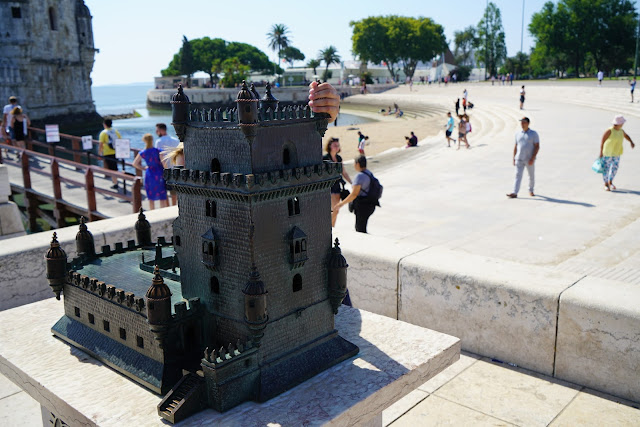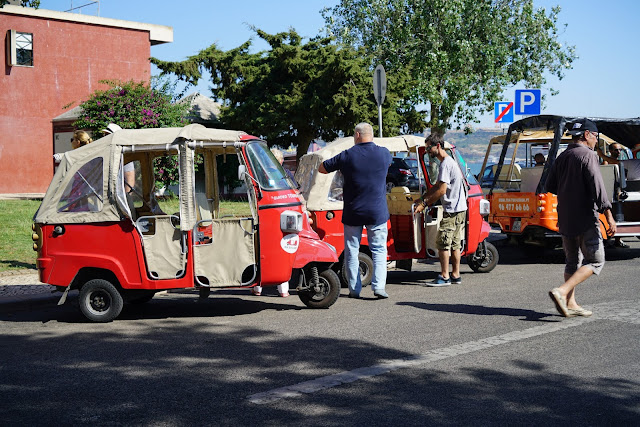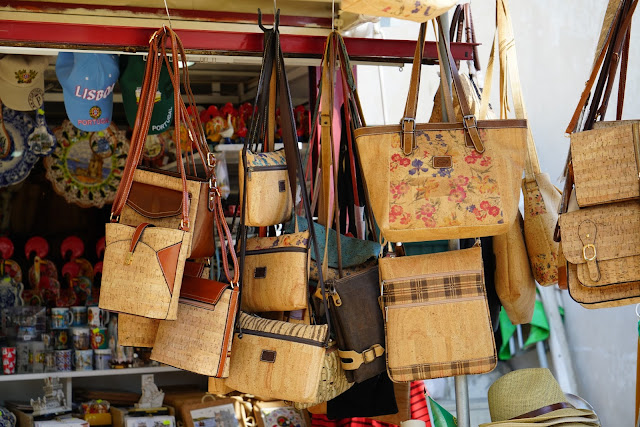After Cabo da Roca, we were told that we'd be driven to town to see a monument for various people connected with the Portuguese Age of Discoveries called "Padrão dos Descobrimentos"( Monument to the Discoveries), north of the Tagus River estuary from which various ships left Portugal in the 15th to 17th centuries to explore and trade with India, China and Japan and other South East Asian countries...

But before that, we were taken to a park where we found the one of first aeroplanes which crossed the south Atlantic Ocean from Lisbon Portugal to Rio de Janeiro, Brazil between March 30 and June 17's. 1922. This daring feat was executed to mark the centennial of Brazil's independence. It covered a distance of some 5,209 miles. It was done in stages by two Portuguese naval aviators Gago Coutinho and Sacadura Cabral, using three different Fairey III double-winged amphibian.planes.


A front view of the amphibian-plane used

I never saw that many flowers in one tree my entire life.


A close up of some of the white flowers

In the water is the famous Torre de Belém
or Belem Tower aka the Tower of St Vincent, the patron saint of Lisbon. The idea for building the fortress to better protect the Tagus River estuary was started by King John II but he died before the plans were drawn. Some 20 years later, the idea was taken up again by King Manuel I who completed it in 1519, 2 years before he died.But in 1580, the garrison stationed there surrendered to the invading Spanish forces from which time on, it began to be used as a prison and this continued until 1830. However, one of the floors there continued to be used as a customs house. Some reinforcements were made there in 1589 and 1809-1814. In 1860's, a beacon was installed in the south-west side of the building to house a telegraph service. It wasn't until 1940 that some serious restoration works were carried out, after its take-over by the Ministry of Finance. In 1953, the military facilities there were removed and the inner cloister there rebuilt . In 1983, it was declared a UNESCO World Heritage Site because of its role in the Age of Discoveries, when ships left it for explorations to various parts of the world including the discoveries of the Atlantic archipelagos of Madeira and the Azores, the coast of Africa, and the discovery of the sea route to India in 1498; and, on behalf of the Crown of Castille (Spain), the trans-Atlantic voyages of Christopher Columbus between 1492 and 1502, and the first circumnavigation of the globe in 1519–1522.



A metallic model of the tower for blind visitors

A mobile booth close by selling some exotic cold fruit beverages like mint lemonade, melon ice tea, Cuban mojito, strawberry Caipiroska and gin tonic.

The stand-up sign in front of the stall

Proof that motorised tricycles are not exclusive to Thais and Vietnamese

Tourist souvenir stalls selling all kinds of mementos and trinkets

Everywhere there you find handbags, purses, cushions and baskets etc. made from, believe it or not, cork!

I touched some of them. They felt really soft and smooth.

The display does not appear to have been done with a great deal of thought. What do you expect? They're cheap stuff.

The prices don't appear to be exorbitant

They look nice and soft.and got nice colors

Across the railway lines, we can see another famous World Heritage building, the Geronimo Monastery, which we were told we would next visit.

but not before we first visited this monument to the glorious " Padrão dos Descobrimentos" or Monument to Discoveries, which unfortunately was under renovation. In front of the monument is a huge compass, called the Rosa-dos-Ventos (Compass Rose) 50M in diameter, a gift of the South African Government, its patterns laid out using different kinds of limestone, including a type of lioz, a rare type of beige colored limestone found only around Lisbon, more specifically in Sintra. Presumaby,they wish to acknowledge the role of Vasca da Gama for discovering the Cape of Good Hope in his sea voyages 1497-1499 to India.

These two photos from Wikipedia show what it would have looked like had it not been covered by the scaffolds. Inside the monuments are a small video-theatre and an exhibition room and there's an elevator which can take one up the top to have a spectacular view of the mouth of River Tagus.

On the eastern profile the monument are shown reliefs of Afonso V of Portugal, Vasco da Gama (discoverer of the sea route to India), Afonso Gonçalves Baldaia (navigator), Pedro Álvares Cabral (discoverer of Brazil), Ferdinand Magellan (first to circumnavigate the globe), Nicolau Coelho (navigator), Gaspar Corte-Real (navigator), Martim Afonso de Sousa (navigator), João de Barros (writer), Estêvão da Gama (sea captain), Bartolomeu Dias (first to cross over the Cape of Good Hope), Diogo Cão (first to arrive to the Congo river), António de Abreu (navigator), Afonso de Albuquerque (second viceroy of Portuguese India), Saint Francis Xavier (missionary) and Cristóvão da Gama (captain),

(Photo from Wikipedia)
On the western profile are the reliefs of Peter, Duke of Coimbra (son of King John I of Portugal), Queen Philippa of Lancaster, Fernão Mendes Pinto (explorer and writer), Frei Gonçalo de Carvalho, O.P. (Dominican Missionary), Frei Henrique de Coimbra, O.F.M. (Franciscan Missionary), Luís de Camões (renaissance poet who celebrated the navigations in the epic the Lusiads), Nuno Gonçalves (painter), Gomes Eanes de Zurara (chronicler), Pêro da Covilhã (traveller), Jácome de Maiorca (cartographer), Pedro Escobar (pilot), Pedro Nunes (mathematician), Pêro de Alenquer (pilot), Gil Eanes (navigator), João Gonçalves Zarco (navigator) and Ferdinand the Holy Prince (son of King John I of Portugal)

(Photo from Wikipedia)
At the head of the two retinues on both sides of the monument is Prince Henry, the Navigator.

In front of the monument is a map of the world done in various kinds of limestones. In the unknown oceans probably lurked all kinds of sea monsters

part of the map showing India and now Sri Lanka

Sailors probably would ask for more money unless they're promised mermaids
Whether or not that's so, sailing ships need good winds.

This map (by Universalis is derived from Zámořské cesty Portugalcůa Španělů.jpg:, CC BY-SA 4.0, https://commons.wikimedia.org/w/index.php?curid=35668506) show the various lands "discovered" in the various voyages by different explorers from the Iberian Peninsula.
According to a Wikipedia article on the subject, as early as 1415, Ceuta was conquered by the Portuguese trying to control navigation of the African coast. Young prince Henry the Navigator was there and became aware of the tremendous potentials for profit in the Trans-Saharan trade routes. For centuries slave and gold trade routes linking West Africa with the Mediterranean passed over the Western Sahara Desert were controlled by the Moors of North Africa. Henry wished to know how far the Muslim territories in Africa extended. He was hoping to bypass them so that he might trade directly with West Africa by sea, find allies in the legendary Christian lands to the south like the long-lost Christian kingdom of Prester John and to probe whether it was possible to reach the Indies by sea, the source of the lucrative spice trade. He therefore invested in sponsoring voyages down the coast of Mauritania, gathering a group of merchants, shipowners and stakeholders interested in new sea lanes. Sponsored by Prince Henry:
1. João Gonçalves Zaras soon discovered the Atlantic islands of Madeira (1419) and the Azores (1427) and he set up settlements in Madeira.
2. In 1456 Diogo Gomes reached the Cape Verde archipelago.
3. In the next decade several captains at the service of Prince Henry – including the Genoese Antonio da Noli and Venetian Alvise Cadamosto – discovered the remaining islands, which were occupied during the 15th century. The Gulf of Guinea would be reached in the 1460s.
4. In 1460 Pedro de Sintra reached Sierra Leone.
So many new places were being "discovered" by the Iberian monarchies that to avoid further conflicts between them, Portugal and Castile signed the Treaty of Tordesillas in 1494 dividing the world into two regions of exploration along a meridian 370 leagues from west of the Cape Verde islands, off the coast of west Africa so that each had exclusive rights to claim newly discovered lands.
5. In 1498, a Portuguese expedition commanded by Vasco da Gama reached India by sailing around what's now called the Cape of Good Hope in South Africa, opening up direct trade with Asia.
6. While other exploratory fleets were sent from Portugal to northern North America, in the following years Portuguese India Armadas also extended the Eastern oceanic route to the New World, touching sometimes South America on route to Asia
7. Beginning in 1500, Pedro Alvares Cabral explored the islands in the South Atlantic and Southern Indian Oceans.
8. Soon, the Portuguese sailed further eastward,to the valuable spice islands in 1512, landing in China in 1513. .
9. In 1513, the Spanish Vasco Núñez de Balboa crossed the Ismthmus of Panama and reached the "other sea" from the New World. Thus, Europe first received news of the eastern and western Pacific within a one-year span around 1512.
10. East and west exploration overlapped in 1522, when a Castilian (Spanish) expedition, led by Portuguese navigator Ferdinand Magellan and later by Spanish Basque navigator Juan Sebastiàn Elcano, sailing Westward, completed the first circumnavigation of the world,while Spanish conquistadors explored the inland of the Americas, and later, some of the South Pacific islands.


This map (by Universalis is derived from Zámořské cesty Portugalcůa Španělů.jpg:, CC BY-SA 4.0, https://commons.wikimedia.org/w/index.php?curid=35668506) show the various lands "discovered" in the various voyages by different explorers from the Iberian Peninsula.
According to a Wikipedia article on the subject, as early as 1415, Ceuta was conquered by the Portuguese trying to control navigation of the African coast. Young prince Henry the Navigator was there and became aware of the tremendous potentials for profit in the Trans-Saharan trade routes. For centuries slave and gold trade routes linking West Africa with the Mediterranean passed over the Western Sahara Desert were controlled by the Moors of North Africa. Henry wished to know how far the Muslim territories in Africa extended. He was hoping to bypass them so that he might trade directly with West Africa by sea, find allies in the legendary Christian lands to the south like the long-lost Christian kingdom of Prester John and to probe whether it was possible to reach the Indies by sea, the source of the lucrative spice trade. He therefore invested in sponsoring voyages down the coast of Mauritania, gathering a group of merchants, shipowners and stakeholders interested in new sea lanes. Sponsored by Prince Henry:
1. João Gonçalves Zaras soon discovered the Atlantic islands of Madeira (1419) and the Azores (1427) and he set up settlements in Madeira.
2. In 1456 Diogo Gomes reached the Cape Verde archipelago.
3. In the next decade several captains at the service of Prince Henry – including the Genoese Antonio da Noli and Venetian Alvise Cadamosto – discovered the remaining islands, which were occupied during the 15th century. The Gulf of Guinea would be reached in the 1460s.
4. In 1460 Pedro de Sintra reached Sierra Leone.
So many new places were being "discovered" by the Iberian monarchies that to avoid further conflicts between them, Portugal and Castile signed the Treaty of Tordesillas in 1494 dividing the world into two regions of exploration along a meridian 370 leagues from west of the Cape Verde islands, off the coast of west Africa so that each had exclusive rights to claim newly discovered lands.
5. In 1498, a Portuguese expedition commanded by Vasco da Gama reached India by sailing around what's now called the Cape of Good Hope in South Africa, opening up direct trade with Asia.
6. While other exploratory fleets were sent from Portugal to northern North America, in the following years Portuguese India Armadas also extended the Eastern oceanic route to the New World, touching sometimes South America on route to Asia
7. Beginning in 1500, Pedro Alvares Cabral explored the islands in the South Atlantic and Southern Indian Oceans.
8. Soon, the Portuguese sailed further eastward,to the valuable spice islands in 1512, landing in China in 1513. .
9. In 1513, the Spanish Vasco Núñez de Balboa crossed the Ismthmus of Panama and reached the "other sea" from the New World. Thus, Europe first received news of the eastern and western Pacific within a one-year span around 1512.
10. East and west exploration overlapped in 1522, when a Castilian (Spanish) expedition, led by Portuguese navigator Ferdinand Magellan and later by Spanish Basque navigator Juan Sebastiàn Elcano, sailing Westward, completed the first circumnavigation of the world,while Spanish conquistadors explored the inland of the Americas, and later, some of the South Pacific islands.

Close by is a berth for pleasure crafts

The yachts may have sails, they got motors too

all neatly moored

The waters are calm,
a globe at the side of the monument

a mobile van having scooters for hire
There's a floating cafe-restaurant




沒有留言:
張貼留言